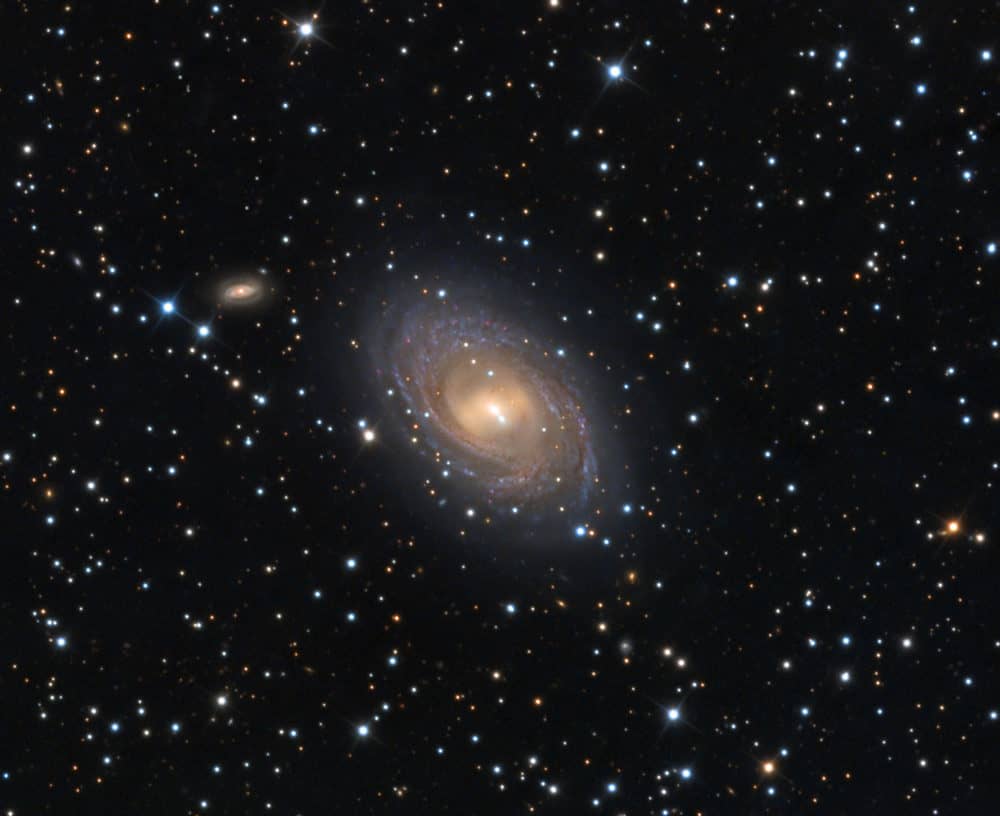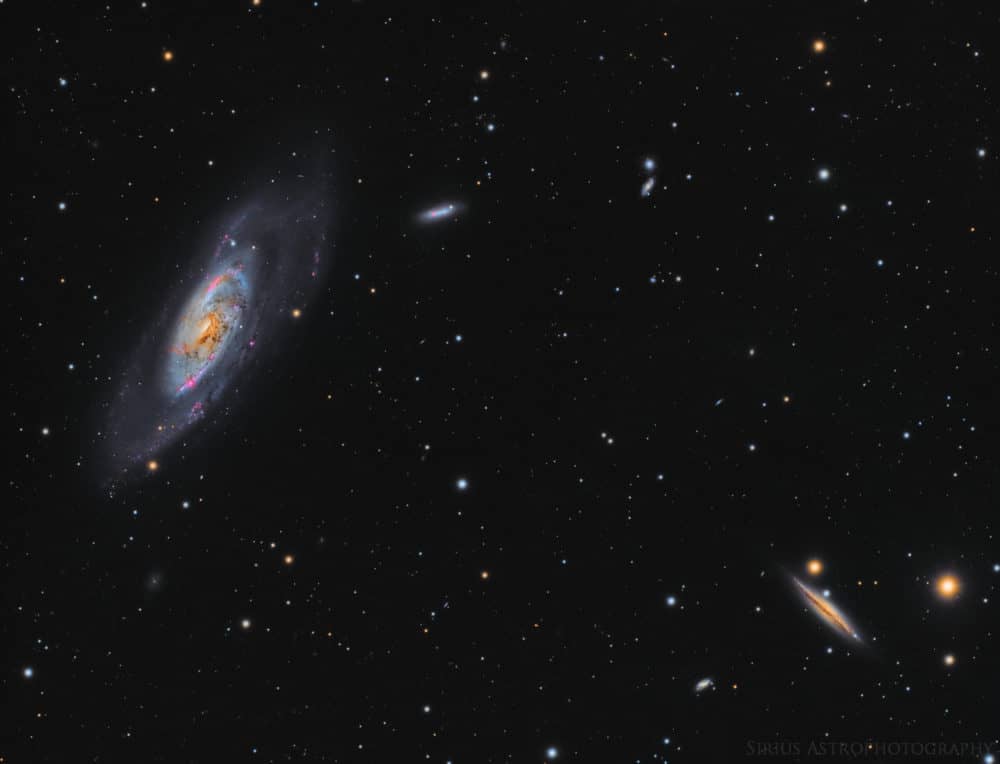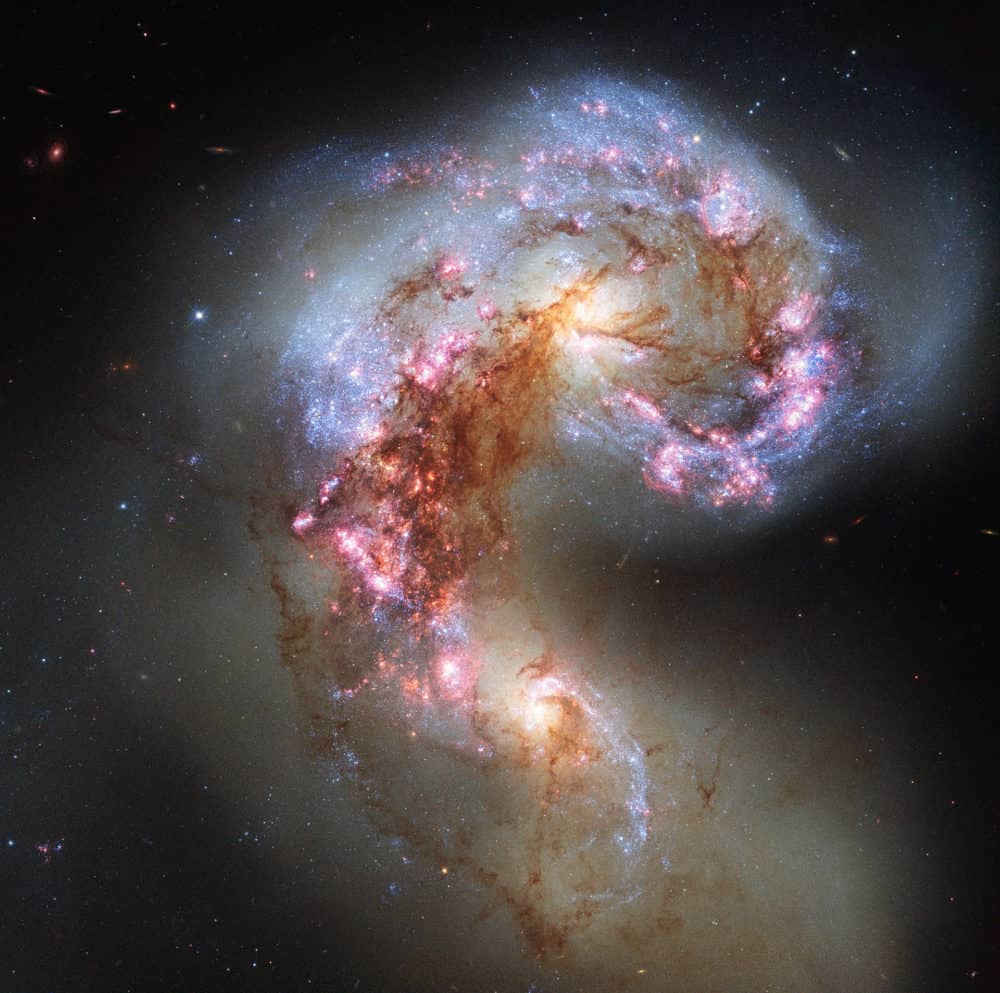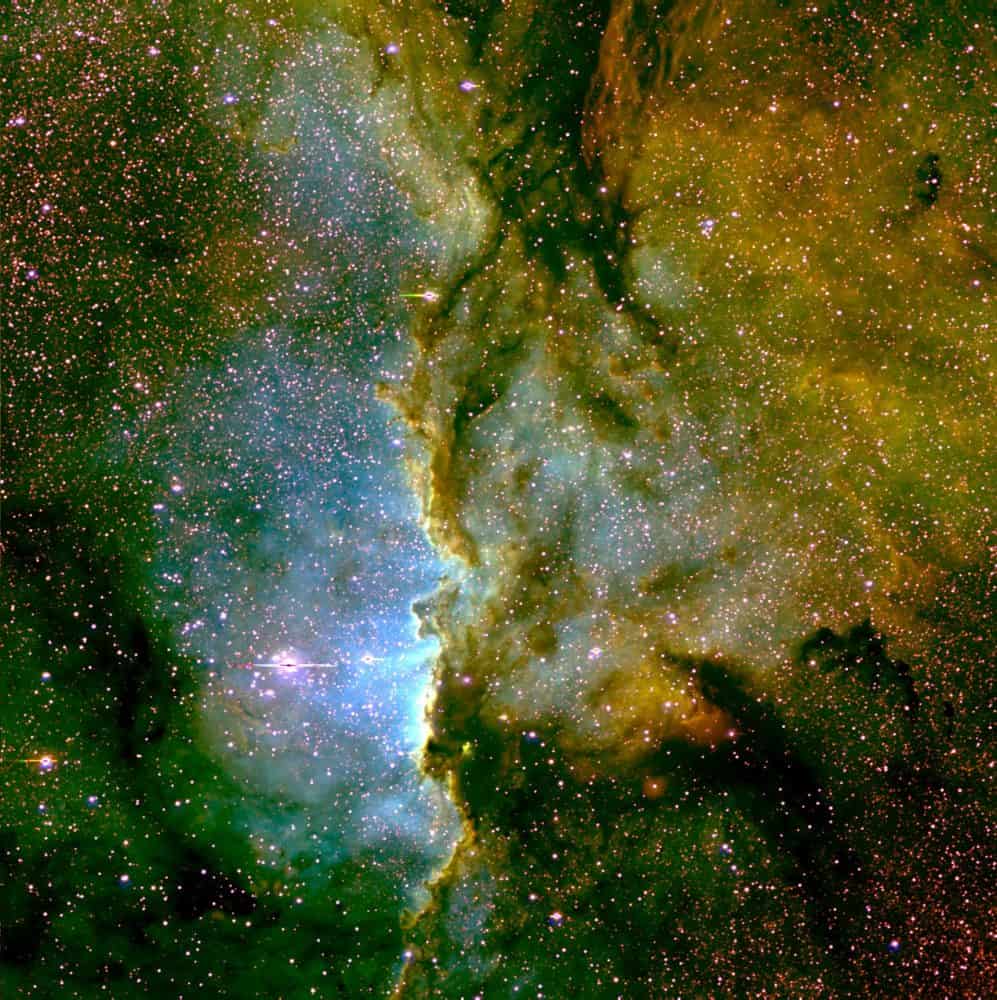Blog
NGC 1169 (UGC 2503) is an intermediate barred spiral galaxy in the constellation of Perseus. NGC 1169 has a reddish center, indicating the region is dominated by older stars. In contrast, the outer ring contains larger blue-white stars, a sign of recent star formation. The entire galaxy is rotating at approximately 265 km/
NGC 1169 was discovered on December 11, 1786 by William Herschel. Measurements of its distance range from 20.9 Mpc – 49.7 Mpc with an average of 35.1 Mpc. and exhibits a slight ring structure.
NGC 1169 is about 85 million light-years away
more...Horace Swaby (21 June 1954 – 18 May 1999), known as Augustus Pablo, was a Jamaican roots reggae and dub record producer, melodicaplayer and keyboardist, active from the 1970s till his death.
He popularised the use of the melodica (an instrument at that time primarily used in Jamaica to teach music to schoolchildren) in reggae music. His album King Tubbys Meets Rockers Uptown (1976) is often regarded as one of the most important examples of dub. He was born in St. Andrew, Jamaica, and learned to play the organ at the Kingston College School, where a girl lent him a melodica, an instrument that fascinated him. He also met Herman Chin Loy, who after working at his cousin Leslie Kong‘s Beverley’s record shop, had set up his own Aquarius store in Half Way Tree. Swaby recorded early tracks including “Higgi Higgi”, “East of the River Nile”, “Song of the East” and “The Red Sea” between 1971 and 1973 for Chin-Loy’s Aquarius Records. Chin Loy had previously used the name Augustus Pablo generically for keyboard instrumentals recorded by Lloyd Charmers and Glen Adams,[4][5] and Swaby took the name for this recording.
“East of the River Nile”, a unique blend of East Asian and Jamaican sounds, became a moderate hit. He soon joined Now Generation (Mikey Chung‘s band) and played keyboard with them while his friend Clive Chin began his own career as a record producer. Pablo and Chin recorded “Java” (1972) together, as soon as Pablo quit Now Generation and Clive was able to obtain studio time. This instrumental was a massive hit and launched Pablo’s solo career. He recorded with Chin and others including Lee Perry and Chin’s uncle, Leonard Chin. Pablo scored another smash hit with “My Desire” (John Holt).
Pablo formed the labels Hot Stuff, Message and Rockers (named after his brother’s soundsystem, Rockers), and released a steady stream of well-received instrumentals, mostly versions of older hits from Studio One. In spite of his success with Rockers, Pablo’s 1974 album, This Is Augustus Pablo was recorded with Clive and Pat Chin. This was followed by a collaboration with the legendary reggae engineer King Tubby, 1975’s Ital Dub.
Pablo produced a steady stream of hits in the late 1970s, including the hit “Black Star Liner” (Fred Locks). He also worked with Dillinger, Norris Reid, I-Roy, Jacob Miller, The Immortals, Paul Blackman, Earl Sixteen, Roman Stewart, Lacksley Castell, The Heptones, Bob Marley, Ricky Grant, Delroy Wilson, Junior Delgado, Horace Andy and Freddy McKay. This period was eventually commemorated with a series of critically acclaimed LPs including King Tubbys Meets Rockers Uptown (1976) and Hugh Mundell‘s classic Africa Must Be Free by 1983. This was followed by East of the River Nile (1978), Original Rockers (1979) and another acclaimed hit album, Rockers Meets King Tubbys in a Firehouse.
https://www.youtube.com/watch?v=dBTDanqGwtA
more...Boris Claudio Schifrin in Buenos Aires, Argentina
Immensely talented, Argentinian born pianist, conductor and composer who has written over 100 scores for both television & the cinema including the memorable themes to Mission: Impossible (1966), Mannix (1967), Starsky and Hutch (1975), Cool Hand Luke(1967), and Bullitt (1968). Schifrin has regularly worked alongside Clint Eastwood(another jazz music aficionado) on numerous contributions including the theme’s to all the Dirty Harry films, plus Joe Kidd (1972) and Coogan’s Bluff (1968). During his illustrious career, Schifrin has received four Grammy Awards, and has received six Oscar nominations.
Schifrin received his classical music training in both Argentina & France, and is a highly respected jazz pianist. On moving back to Buenos Aires in the mid 1950s, Schifrin formed his own big band, and was noticed by jazz legend Dizzy Gillespie, who asked him to become his pianist and arranger. Schifrin moved to the United States in 1958 and his career really began to take off. In addition to his jazz and cinema compositions, he has conducted the London Philarmonic Orchestra, the Houston Symphony Orchestra, the Los Angelas Philarmonic, the Los Angelas Chamber Orchestra and many others.
https://www.youtube.com/watch?v=7HFakjigeFc
Alexandre Lagoya (29 June 1929 – 24 August 1999) was a French classical guitarist and composer. His early career included boxing and guitar, and as he cites on the sleeve of a 1981 Columbia album, his parents hoped he would outgrow his predilection for both.
Lagoya was born in Alexandria, Egypt, to a Greek father and an Italian mother. By 1955, when he married the French guitarist Ida Presti, his career had already begun. On the sleeve of his 1981 record with Columbia, Lagoya pays deep tribute to Presti and admits that after her premature death he was unable to play for years. He returned to the guitar as a teacher, tutoring among other famous guitarists the Canadian virtuoso Liona Boyd (who claims in her autobiography that she was also his lover). In the early 1980s, at the advanced age of 52, he burst back on the international scene with a record for Columbia and an international tour.
Lagoya played a variety of works for guitar, performing concerts and recording albums, often collaborating with Presti and also with other musicians. Lagoya was also a successful teacher. He taught at the Conservatoire de Paris and, in Canada, and developed a new method of hand positioning which he believed helped people learn to play the guitar better. He also added the use of the little finger to plucking and claimed to have invented a method for maximizing the sound coming from the classical guitar.
https://www.youtube.com/watch?v=W304E_XCZd8&t=26s
more...Nehemiah Curtis “Skip” James (June 9, 1902 – October 3, 1969) was an American Delta blues singer, guitarist, pianist and songwriter.
His guitar playing is noted for its dark, minor-key sound, played in an open D-minor tuning with an intricate fingerpicking technique. James first recorded for Paramount Records in 1931, but these recordings sold poorly, having been released during the Great Depression, and he drifted into obscurity.
After a long absence from the public eye, James was rediscovered in 1964 by blues enthusiasts, helping further the blues and folk music revival of the 1950s and early 1960s. During this period, James appeared at folk and blues festivals, gave concerts around the country and recorded several albums for various record labels. His songs have influenced generations of musicians and have been adapted by numerous artists. He has been hailed as “one of the seminal figures of the blues.”
James was born near Bentonia, Mississippi. His father was a bootlegger who reformed and became a preacher. As a youth, James heard local musicians, such as Henry Stuckey, from whom he learned to play the guitar, and the brothers Charlie and Jesse Sims. James began playing the organ in his teens. He worked on road construction and levee-building crews in Mississippi in the early 1920s and wrote what is perhaps his earliest song, “Illinois Blues”, about his experiences as a laborer. He began playing the guitar in open D-minor tuning.
more...Flamenco Fridays palo Bulerias.
When performed, the bulería usually starts on beat twelve of the compas, so the accented beat is heard first.
It is played at about 240 beats per minute, most commonly in an A-phrygian mode, with a sharpened third to make A major the root chord. A typical rasgueado (a strumming pattern that sets the rhythm) involves only the A and B♭ chords as follows:
Big, bright, beautiful spiral, Messier 106 dominates this cosmic vista. The nearly two degree wide telescopic field of view looks toward the well-trained constellation Canes Venatici, near the handle of the Big Dipper. Also known as NGC 4258, M106 is about 80,000 light-years across and 23.5 million light-years away, the largest member of the Canes II galaxy group. For a far away galaxy, the distance to M106 is well-known in part because it can be directly measured by tracking this galaxy’s remarkable maser, or microwave laser emission. Very rare but naturally occurring, the maser emission is produced by water molecules in molecular clouds orbiting its active galactic nucleus. Another prominent spiral galaxy on the scene, viewed nearly edge-on, is NGC 4217 below and right of M106. The distance to NGC 4217 is much less well-known, estimated to be about 60 million light-years.
more...Leslie Johnson (June 20, 1933 – August 22, 2018), better known as Lazy Lester, was an American blues musician who sang and played the harmonica and guitar. His career spanned the 1950s to 2018.
Best known for regional hits recorded with Ernie Young’s Nashville-based Excello Records, Lester also contributed to songs recorded by other Excello artists, including Slim Harpo, Lightnin’ Slim, and Katie Webster. Cover versions of his songs have been recorded by (among others) the Kinks, the Flamin’ Groovies, Freddy Fender, Dwight Yoakam, Dave Edmunds, Raful Neal, Anson Funderburgh, and the Fabulous Thunderbirds. In the comeback stage of his career (since the late 1980s) he recorded new albums backed by Mike Buck, Sue Foley, Gene Taylor, Kenny Neal, Lucky Peterson, and Jimmie Vaughan.
In the mid-1950s, Lester was on the margins of the Louisiana blues scene. According to Rolling Stone (February 23, 2006), Buddy Guy, before moving to Chicago, had played in Louisiana “with some of the old masters: Lightnin’ Hopkins, Lazy Lester, Slim Harpo.” When Guy left for Chicago, in 1957, Lester replaced him, on guitar, in a local band—even though Lester, at the time, did not own one.
more...Eric Allan Dolphy, Jr. (June 20, 1928 – June 29, 1964) was an American jazz alto saxophonist, bass clarinetist and flautist. On a few occasions, he also played the clarinet and piccolo. Dolphy was one of several multi-instrumentalists to gain prominence around the time that he was active. His use of the bass clarinet helped to establish the instrument within jazz. Dolphy extended the vocabulary and boundaries of the alto saxophone, and was among the earliest significant jazz flute soloists.
His improvisational style was characterized by the use of wide intervals, in addition to using an array of extended techniques to emulate the sounds of human voices and animals. Although Dolphy’s work is sometimes classified as free jazz, his compositions and solos were often rooted in conventional (if highly abstracted) tonal bebop harmony and melodic lines that suggest the influences of modern classical composers such as Béla Bartók and Igor Stravinsky. Dolphy was born in Los Angeles to Eric Allan Dolphy, Sr. and Sadie Dolphy, who immigrated to the United States from Panama. He picked up the clarinet at the age of six, and in less than a month was playing in the school’s orchestra. He also learned the oboe in junior high school, though he never recorded on the instrument. Hearing Fats Waller, Duke Ellington and Coleman Hawkins led him toward jazz, and he picked up the saxophoneand flute while in high school.
The Antennae Galaxies, also known as NGC 4038/NGC 4039, are a pair of interacting galaxies in the constellation Corvus. They are currently going through a starburst phase, in which the collision of clouds of gas and dust, with entangled magnetic fields, causes rapid star formation. They were discovered by William Herschel in 1785.
The Antennae Galaxies are undergoing a galactic collision. Located in the NGC 4038 group with five other galaxies, these two galaxies are known as the Antennae Galaxies because the two long tails of stars, gas and dust ejected from the galaxies as a result of the collision resemble an insect’s antennae. The nuclei of the two galaxies are joining to become one giant galaxy. Most galaxies probably undergo at least one significant collision in their lifetimes. This is likely the future of our Milky Way when it collides with the Andromeda Galaxy.
Five supernovae have been discovered in NGC 4038: SN 1921A, SN 1974E, SN 2004GT, SN 2007sr and SN 2013dk.
A recent study finds that these interacting galaxies are less remote from the Milky Way than previously thought—at 45 million light-years instead of 65 million light-years.
more...Willis Robert “Billy” Drummond Jr. (born June 19, 1959 in Newport News, Virginia) is an American jazz drummer.
Drummond learned jazz from an early age from his father, who was a drummer and a jazz enthusiast and whose record collection included many recordings of Miles Davis, Art Blakey, Max Roach, Buddy Rich and Elvin Jones. He played in bands from age eight and studied at Shenandoah College and Conservatory of Music.
He moved to New York at the behest of Al Foster in 1986 and shortly thereafter joined the Blue Note band, Out of the Blue, with whom he recorded their last album. He joined the Horace Silver sextet, with whom he toured extensively, before joining Sonny Rollins, with whom he toured for three years. He is a long-time member of Carla Bley‘s Lost Chords Quartet, Sheila Jordan‘s Quartet, and the Steve Kuhn Trio. He also leads a New York-based band called Freedom of Ideas. In addition to touring he is Professor of Jazz Drums at the Juilliard School and New York University.
A sideman on over 300 records, Drummond has played and recorded with Nat Adderley, Ralph Moore (1989 and subsequently), Buster Williams(1990–93), Charles Tolliver (1991), Lew Tabackin and Toshiko Akiyoshi, Hank Jones (1991), James Moody (early 1990s), Sonny Rollins, Andy LaVerne (1994), Lee Konitz (1995), Dave Stryker (1996), George Colligan (1997), Ted Rosenthal, Bruce Barth, Andrew Hill (from 1997–2000), Larry Willis (2006 to the present), Toots Thielmans, Freddie Hubbard (mid-1990s), Chris Potter, Eddie Gómez, Stanley Cowell, Javon Jackson, and Sheila Jordan (1990s to present). Influences include Tony Williams, Max Roach, Philly Joe Jones, Al Foster, Jack DeJohnette, and Billy Hart. Previously married to pianist Renee Rosnes, Drummond has been a resident of West Orange, New Jersey.
more...Ernest Ranglin OD (born 19 June 1932) is a Jamaican guitarist and composer who established his career while working as a session guitarist and music director for various Jamaican record labels including Studio One and Island Records. Ranglin played guitar on many early ska recordings and helped create the rhythmic guitar style that defined the form. Ranglin has worked with Theophilus Beckford, Jimmy Cliff, Monty Alexander, Prince Buster, the Skatalites, Bob Marley and the Eric Deans Orchestra. He is noted for a chordal and rhythmic approach that blends jazz, mento and reggaewith percussive guitar solos incorporating rhythm ‘n’ blues and jazz inflections.
Ernest Ranglin was born in Manchester, Jamaica. His family moved to Kingston, where he attended the Providence Primary School, Kingston Senior School and Bodin College. Ranglin’s introduction to music was through two uncles who both played guitar. Initially a self-taught guitarist; he received some tutoring on how to sight-read from a violin player named Tommy Tomlins. At the age of 15, Ranglin joined the Val Bennett Orchestra, which was followed by a period of employment with the Eric Deans Orchestra. While performing locally with these orchestras Ranglin was introduced to the jazz pianist Monty Alexander, which led to a lifelong friendship as well as numerous musical collaborations. During the 1950s Ranglin played guitar on calypso and mento releases, some of which were recorded for the tourist market. The 1958 album The Wrigglers Sing Calypso at the Arawak is representative of the type of calypso floor show that Jamaican bands performed at hotels (some of the tracks from the original album were included on the 2010 CD release Jamaica – Mento 1951-1958). He was employed as a guitarist by the Jamaica Broadcasting Corporation (JBC) between the years 1958 and 1965 with public radio broadcasting (radio services had been established earlier with the first broadcast transmitted in November 1939) commencing in 1959 and television broadcasting commencing in 1963. Ranglin also played with Cluett Johnson’s studio band Clue J and the Blues Blasters; recording several tracks for Coxsone Dodd at Federal Studios, including the Theophilus Beckford hit “Easy Snapping” (recorded in 1956 and released in 1959), which he arranged and played guitar on. Ranglin also played on the Beckford tracks “Jack and Jill Shuffle” and “Shuffling Jug.”
more...Albert King (1912–1981), known as Bertie King, was a Jamaican jazz and mento musician. He played the clarinet and the saxophone. King was born in Panama, and raised in Kingston, where he attended Alpha Boys School.
During the 1930s he led his own band, Bertie King and his Rhythm Aces, described at the time as “Jamaica’s Foremost Dance Orchestra”. In 1936 he left for England, sailing on the same ship as his friend Jiver Hutchinson. In London he joined Ken Snakehips Johnson‘s West Indian Dance Band, and later played with Leslie Hutchinson’s band. He also worked with visiting American musicians including Benny Carter, George Shearing and Coleman Hawkins. In 1937 he recorded four sides in the Netherlands with Benny Carter, and in 1938 he recorded with Django Reinhardt in Paris. In 1939 he joined the Royal Navy. He left the Navy in 1943 and formed his own band, also working and recording with Nat Gonella.
King returned to Jamaica in 1951, where he started his own band, known as the Casa Blanca Orchestra, playing in the mento style. Since there were no Jamaican record labels at this time, he arranged for his recordings to be pressed in a plant in Lewisham, England, owned by Decca Records. He returned a number of times to England, working and recording with Kenny Baker, George Chisholm, Chris Barber, Kenny Graham and Humphrey Lyttelton, and also toured in Asia and Africa with his own band. During this period he also played and recorded in London with some of the leading Trinidadian calypsonians. He was noted for his impassive demeanour on stage, which belied an expressive playing style.
King led the Jamaica Broadcasting Corporation‘s house band in the 1950s; his sidemen included Ernest Ranglin and Tommy Mowatt. He recorded extensively with this outfit. In 1965 he moved to the USA. His last known public performance was at Jamaican Independence Day celebrations in New York City in 1967. He died in the USA in 1981.
more...NGC 6188 is an emission nebula located about 4,000 light years away in the constellation Ara. The bright open cluster NGC 6193, visible to the naked eye, is responsible for a region of reflection nebulosity within NGC 6188.
NGC 6188 is a star forming nebula, and is sculpted by the massive, young stars that have recently formed there – some are only a few million years old. This spark of formation was probably caused when the last batch of stars went supernova.
more...Sir James Paul McCartney CH MBE (born 18 June 1942) is an English singer-songwriter, multi-instrumentalist, and composer. He gained worldwide fame as the bass guitarist and singer for the rock band the Beatles, widely considered the most popular and influential group in the history of popular music. McCartney is one of the most successful composers and performers of all time. He has written, or co-written, 32 songs that have reached number one on the Billboard Hot 100, and as of 2009 he had 25.5 million RIAA-certified units in the United States. His songwriting partnership withJohn Lennon remains the most successful in history. After the group disbanded in 1970, he pursued a solo career and formed the band Wings with his first wife, Linda, and Denny Laine.
More than 2,200 artists have covered McCartney’s the Beatles song “Yesterday“, making it one of the most covered songs in popular music history. Wings’ 1977 release “Mull of Kintyre” is one of the all-time best-selling singles in the UK. McCartney has released an extensive catalogue of songs as a solo artist and has composed classical and electronic music. His most recent album Egypt Station (2018) became his first album in 36 years to top the Billboard 200, and his first to debut at number one.
A two-time inductee into the Rock and Roll Hall of Fame (as a member of the Beatles in 1988, and as a solo artist in 1999) and an 18-time Grammy Award winner, McCartney, Lennon, George Harrison and Ringo Starr all received appointment as Members of the Order of the British Empire in 1965 and, in 1997, McCartney was knighted for services to music. He has taken part in projects to promote international charities related to such subjects as animal rights, seal hunting, land mines, vegetarianism, poverty, and music education. He has married three times and is the father of five children. McCartney is also one of the wealthiest musicians in the world, with an estimated net worth of US$1.2 billion.
more...More Posts
- Paul Gonsalves
- World Music Eva Väljaots
- Daily Roots Bunny Wailer
- Jesus Christ Super Star 2022
- Cosmos WR 134
- Michael Rose
- Oscar D’León
- Tomasz Stańko
- SUPPORT UKRAINE Kozak System
- Daily Roots Gregory Isaacs
- Cosmos NGC 6543
- Béla Fleck
- Lee Morgan
- Milt Buckner
- Blind Boy Fuller
- World Fusion NY Gypsy All Stars
- Daily Roots Cedric Brooks & Clement Dodd
- Cosmos NGC 2244
- Mitch Mitchell
- Joe Liggins



